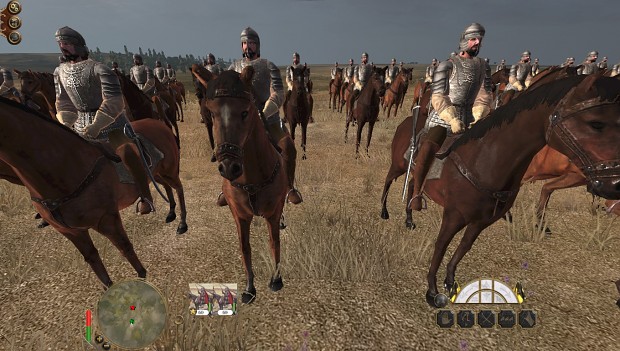17th Century mod for Empire Total War including new models, textures, rulers and historical events.
The term Harquebusier was used to denote the most common form of cavalryman found in Western Europe during the early and mid 17th century. The typical harquebusier would have worn an iron cuirass, with a breast and backplate, and an open faced helmet such as a lobster tailed pot; the fashion conscious could replace the helmet with a broad-brimmed felt hat, often worn over a concealed iron skullcap or secrete. In England, in 1629, a harquebusier's armour cost one pound and six shillings, that of a cuirassier four pounds and ten shillings. A more wealthy harquebusier may have worn a buff coat (the finest quality buff coats were often more expensive than an iron cuirass) under his armour and a metal gauntlet to protect his bridle hand and forearm. The harquebusier would have been armed with a doglock carbine, hung from a swivel attached to a baldric, pistols in saddle holsters and a stout, straight-bladed, sword. The 'dog' of the doglock was a type of safety-catch, very useful to prevent the unintentional firing of the carbine when on horseback.







I always thought the term Harquebus denoted a pre-musket firearm, and hence harquebusier as someone who would wield an harqebus. Not the specific role of harquebusier, be it cavalry or foot, but as the harquebus mostly was quite a cumbersome weapon (sometimes attached to it pikes or axeheads) I typically associated it with footsoldiers.
Nope. The "harquebuse" should not be confused with the "arquebus". A harquebuse was a wheel-lock weapon about as fast as a matchlock but with the firing mechanism being a spring attached to a wheel. The sparks from the spring's recoil ignited the gunpowder.
well so did I thought, well except that the arquebuse would be a comparably small fire arm, while it was the first muskets that was fired from firing forks.
"I typically associated it with footsoldiers." (Guest)
Well there were also infantry called Arquebusiers. Harquebusiers were cavalry. However whereas arquebusiers fired the arquebus, in the 17th century harquebusiers didn't necessarily, but the term lived on anyway.
There are also infantry arquebusiers in this mod.
"well so did I thought, well except that the arquebuse would be a comparably small fire arm, while it was the first muskets that was fired from firing forks. "
Firing forks were used more often for infantry arquebusiers than musketeers because they were heavier. In the early 17th century, the musket was also heavy so it was often used there too. But the fork rest was also useful as a directional targeting tool so in some countries e.g. Spain continued in use (as did the arquebus in that country) throughout the century. In 1683 the fork rest was sometimes used by Saxon musketeers according to our sources.